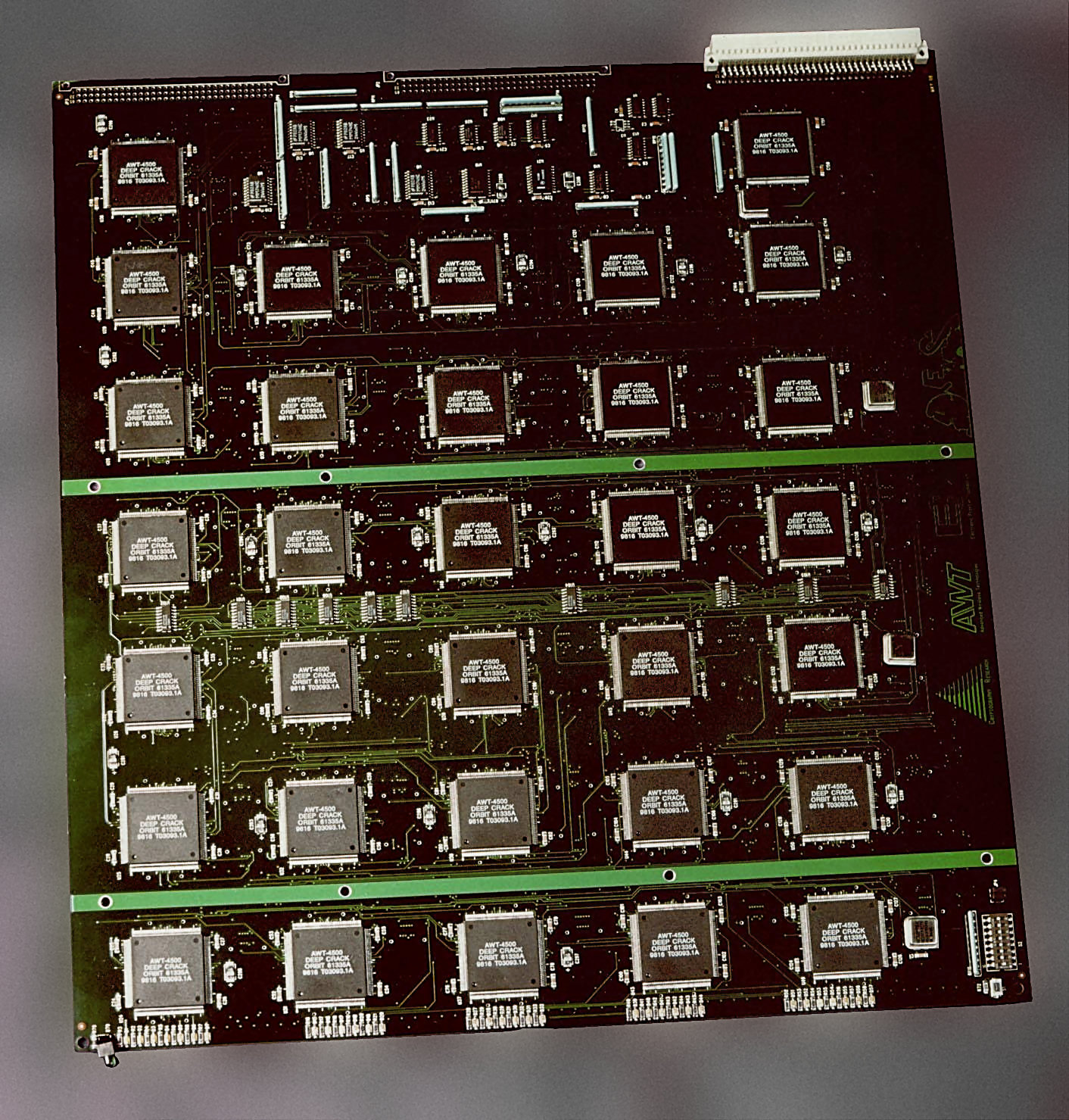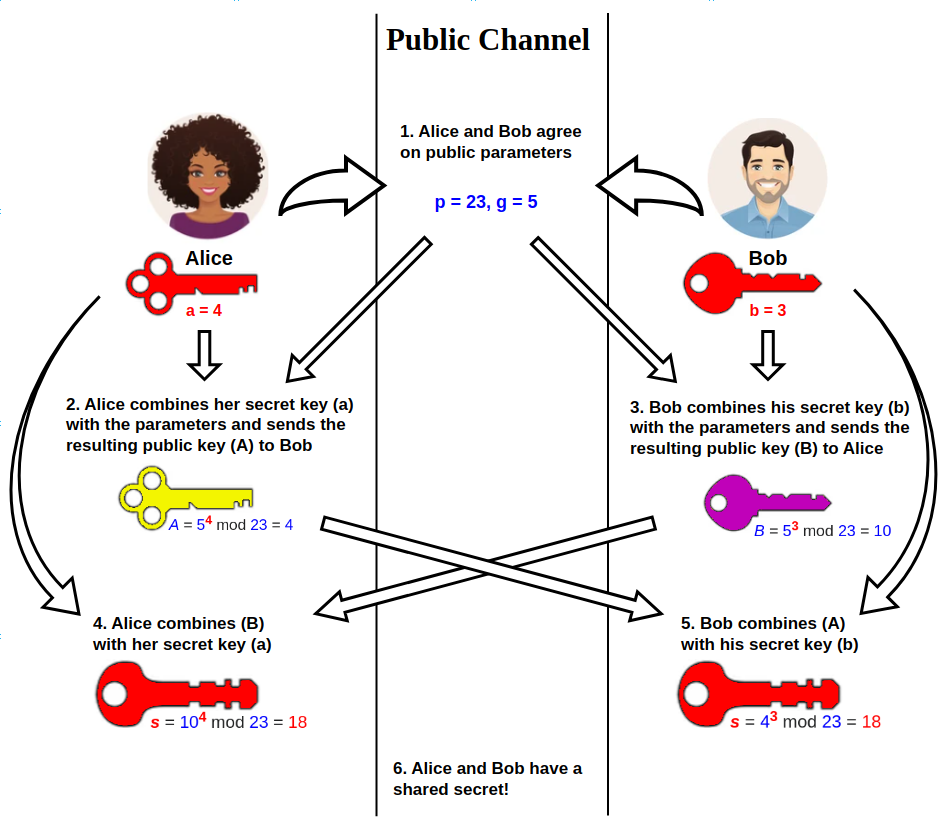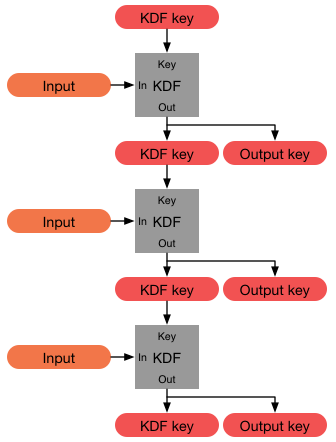|
Key Generation
Key generation is the process of generating keys in cryptography. A key is used to encrypt and decrypt whatever data is being encrypted/decrypted. A device or program used to generate keys is called a key generator or keygen. Generation in cryptography Modern cryptographic systems include symmetric-key algorithms (such as DES and AES) and public-key algorithms (such as RSA). Symmetric-key algorithms use a single shared key; keeping data secret requires keeping this key secret. Public-key algorithms use a public key and a private key. The public key is made available to anyone (often by means of a digital certificate). A sender encrypts data with the receiver's public key; only the holder of the private key can decrypt this data. Since public-key algorithms tend to be much slower than symmetric-key algorithms, modern systems such as TLS and SSH use a combination of the two: one party receives the other's public key, and encrypts a small piece of data (either a symmetric key ... [...More Info...] [...Related Items...] OR: [Wikipedia] [Google] [Baidu] [Amazon] |
Cryptography
Cryptography, or cryptology (from "hidden, secret"; and ''graphein'', "to write", or ''-logy, -logia'', "study", respectively), is the practice and study of techniques for secure communication in the presence of Adversary (cryptography), adversarial behavior. More generally, cryptography is about constructing and analyzing Communication protocol, protocols that prevent third parties or the public from reading private messages. Modern cryptography exists at the intersection of the disciplines of mathematics, computer science, information security, electrical engineering, digital signal processing, physics, and others. Core concepts related to information security (confidentiality, data confidentiality, data integrity, authentication, and non-repudiation) are also central to cryptography. Practical applications of cryptography include electronic commerce, Smart card#EMV, chip-based payment cards, digital currencies, password, computer passwords, and military communications. ... [...More Info...] [...Related Items...] OR: [Wikipedia] [Google] [Baidu] [Amazon] |
Algorithm
In mathematics and computer science, an algorithm () is a finite sequence of Rigour#Mathematics, mathematically rigorous instructions, typically used to solve a class of specific Computational problem, problems or to perform a computation. Algorithms are used as specifications for performing calculations and data processing. More advanced algorithms can use Conditional (computer programming), conditionals to divert the code execution through various routes (referred to as automated decision-making) and deduce valid inferences (referred to as automated reasoning). In contrast, a Heuristic (computer science), heuristic is an approach to solving problems without well-defined correct or optimal results.David A. Grossman, Ophir Frieder, ''Information Retrieval: Algorithms and Heuristics'', 2nd edition, 2004, For example, although social media recommender systems are commonly called "algorithms", they actually rely on heuristics as there is no truly "correct" recommendation. As an e ... [...More Info...] [...Related Items...] OR: [Wikipedia] [Google] [Baidu] [Amazon] |
Secret Sharing
Secret sharing (also called secret splitting) refers to methods for distributing a secrecy, secret among a group, in such a way that no individual holds any intelligible information about the secret, but when a sufficient number of individuals combine their 'shares', the secret may be reconstructed. Whereas ''insecure'' secret sharing allows an attacker to gain more information with each share, ''secure'' secret sharing is 'all or nothing' (where 'all' means the necessary number of shares). In one type of secret sharing scheme there is one ''dealer'' and ''n'' ''players''. The dealer gives a share of the secret to the players, but only when specific conditions are fulfilled will the players be able to reconstruct the secret from their shares. The dealer accomplishes this by giving each player a share in such a way that any group of ''t'' (for ''threshold'') or more players can together reconstruct the secret but no group of fewer than ''t'' players can. Such a system is called a ... [...More Info...] [...Related Items...] OR: [Wikipedia] [Google] [Baidu] [Amazon] |
Distributed Key Generation
Distributed key generation (DKG) is a cryptographic process in which multiple parties contribute to the calculation of a shared public and private key set. Unlike most public key encryption models, distributed key generation does not rely on Trusted Third Parties. Instead, the participation of a threshold of honest parties determines whether a key pair can be computed successfully. Distributed key generation prevents single parties from having access to a private key. The involvement of many parties requires Distributed key generation to ensure secrecy in the presence of malicious contributions to the key calculation. Distributed key generation is commonly used to decrypt shared ciphertexts or create group digital signatures. History Distributed key generation protocol was first specified by Torben Pedersen in 1991. This first model depended on the security of the Joint-Feldman Protocol for verifiable secret sharing during the secret sharing process. In 1999, Rosario Gen ... [...More Info...] [...Related Items...] OR: [Wikipedia] [Google] [Baidu] [Amazon] |
128-bit
General home computing and gaming utility emerged at 8-bit word sizes, as 28=256 Word (computer architecture), words, a natural unit of data, became possible. Early 8-bit CPUs (such as the Zilog Z80 and MOS Technology 6502, used in the 1977 Commodore PET, PET, TRS-80, and Apple II) inaugurated the era of personal computing. Many 16-bit CPUs already existed in the mid-1970s. Over the next 30 years, the shift to 16-bit, 32-bit and 64-bit computing allowed, respectively, 216 = 65,536 unique words, 232 = 4,294,967,296 unique words and 264 = unique words, each step offering a meaningful advantage until 64 bits was reached. Further advantages evaporate from 64-bit to 128-bit computing as the number of possible values in a register increases from roughly 18 Names of large numbers, quintillion () to 340 Names of large numbers, undecillion () as so many unique values are never utilized. Thus, with a register that can store 2128 values, no advantages over 64 ... [...More Info...] [...Related Items...] OR: [Wikipedia] [Google] [Baidu] [Amazon] |
Key Length
In cryptography, key size or key length refers to the number of bits in a key used by a cryptographic algorithm (such as a cipher). Key length defines the upper-bound on an algorithm's security (i.e. a logarithmic measure of the fastest known attack against an algorithm), because the security of all algorithms can be violated by brute-force attacks. Ideally, the lower-bound on an algorithm's security is by design equal to the key length (that is, the algorithm's design does not detract from the degree of security inherent in the key length). Most symmetric-key algorithms are designed to have security equal to their key length. However, after design, a new attack might be discovered. For instance, Triple DES was designed to have a 168-bit key, but an attack of complexity 2112 is now known (i.e. Triple DES now only has 112 bits of security, and of the 168 bits in the key the attack has rendered 56 'ineffective' towards security). Nevertheless, as long as the security (understood as ... [...More Info...] [...Related Items...] OR: [Wikipedia] [Google] [Baidu] [Amazon] |
Brute-force Attack
In cryptography, a brute-force attack or exhaustive key search is a cryptanalytic attack that consists of an attacker submitting many possible keys or passwords with the hope of eventually guessing correctly. This strategy can theoretically be used to break any form of encryption that is not information-theoretically secure. However, in a properly designed cryptosystem the chance of successfully guessing the key is negligible. When cracking passwords, this method is very fast when used to check all short passwords, but for longer passwords other methods such as the dictionary attack are used because a brute-force search takes too long. Longer passwords, passphrases and keys have more possible values, making them exponentially more difficult to crack than shorter ones due to diversity of characters. Brute-force attacks can be made less effective by obfuscating the data to be encoded making it more difficult for an attacker to recognize when the code has been cracked or by ma ... [...More Info...] [...Related Items...] OR: [Wikipedia] [Google] [Baidu] [Amazon] |
Diffie–Hellman Key Exchange
Diffie–Hellman (DH) key exchangeSynonyms of Diffie–Hellman key exchange include: * Diffie–Hellman–Merkle key exchange * Diffie–Hellman key agreement * Diffie–Hellman key establishment * Diffie–Hellman key negotiation * Exponential key exchange * Diffie–Hellman protocol * Diffie–Hellman handshake is a mathematical method of securely generating a symmetric cryptographic key over a public channel and was one of the first public-key protocols as conceived by Ralph Merkle and named after Whitfield Diffie and Martin Hellman. DH is one of the earliest practical examples of public key exchange implemented within the field of cryptography. Published in 1976 by Diffie and Hellman, this is the earliest publicly known work that proposed the idea of a private key and a corresponding public key. Traditionally, secure encrypted communication between two parties required that they first exchange keys by some secure physical means, such as paper key lists transported by a tr ... [...More Info...] [...Related Items...] OR: [Wikipedia] [Google] [Baidu] [Amazon] |
Key Management
Key management refers to management of Key (cryptography), cryptographic keys in a cryptosystem. This includes dealing with the generation, exchange, storage, use, crypto-shredding (destruction) and replacement of keys. It includes cryptographic protocol design, Key server (cryptographic), key servers, user procedures, and other relevant protocols. Key management concerns keys at the user level, either between users or systems. This is in contrast to key scheduling, which typically refers to the internal handling of keys within the operation of a cipher. Successful key management is critical to the security of a cryptosystem. It is the more challenging side of cryptography in a sense that it involves aspects of social engineering such as system policy, user training, organizational and departmental interactions, and coordination between all of these elements, in contrast to pure mathematical practices that can be automated. Types of keys Cryptographic systems may use different ... [...More Info...] [...Related Items...] OR: [Wikipedia] [Google] [Baidu] [Amazon] |
Forward Secrecy
In cryptography, forward secrecy (FS), also known as perfect forward secrecy (PFS), is a feature of specific key-agreement protocols that gives assurances that session keys will not be compromised even if long-term secrets used in the session key exchange are compromised, limiting damage. For TLS, the long-term secret is typically the private key of the server. Forward secrecy protects past sessions against future compromises of keys or passwords. By generating a unique session key for every session a user initiates, the compromise of a single session key will not affect any data other than that exchanged in the specific session protected by that particular key. This by itself is not sufficient for forward secrecy which additionally requires that a long-term secret compromise does not affect the security of past session keys. Forward secrecy protects data on the transport layer of a network that uses common transport layer security protocols, including OpenSSL, when its long-te ... [...More Info...] [...Related Items...] OR: [Wikipedia] [Google] [Baidu] [Amazon] |
Key Derivation Function
In cryptography, a key derivation function (KDF) is a cryptographic algorithm that derives one or more secret keys from a secret value such as a master key, a password, or a passphrase using a pseudorandom function (which typically uses a cryptographic hash function or block cipher). KDFs can be used to stretch keys into longer keys or to obtain keys of a required format, such as converting a group element that is the result of a Diffie–Hellman key exchange into a symmetric key for use with AES. Keyed cryptographic hash functions are popular examples of pseudorandom functions used for key derivation. History The first deliberately slow (key stretching) password-based key derivation function was called "crypt" (or "crypt(3)" after its man page), and was invented by Robert Morris in 1978. It would encrypt a constant (zero), using the first 8 characters of the user's password as the key, by performing 25 iterations of a modified DES encryption algorithm (in which a 12-b ... [...More Info...] [...Related Items...] OR: [Wikipedia] [Google] [Baidu] [Amazon] |
Passphrase
A passphrase is a sequence of words or other text used to control access to a computer system, program or data. It is similar to a password in usage, but a passphrase is generally longer for added security. Passphrases are often used to control both access to, and the operation of, Cryptography, cryptographic programs and systems, especially those that derive an encryption key from a passphrase. The origin of the term is by analogy with ''password''. The modern concept of passphrases is believed to have been invented by Sigmund N. Porter in 1982. Security Source: Considering that the information entropy, entropy of written English is less than 1.1 bits per character, passphrases can be relatively weak. NIST has estimated that the 23-character passphrase "IamtheCapitanofthePina4" contains a 45-bit strength. The equation employed here is: : 4 bits (1st character) + 14 bits (characters 2–8) + 18 bits (characters 9–20) + 3 bits (characters 21–23) + 6 bits (bonus f ... [...More Info...] [...Related Items...] OR: [Wikipedia] [Google] [Baidu] [Amazon] |





